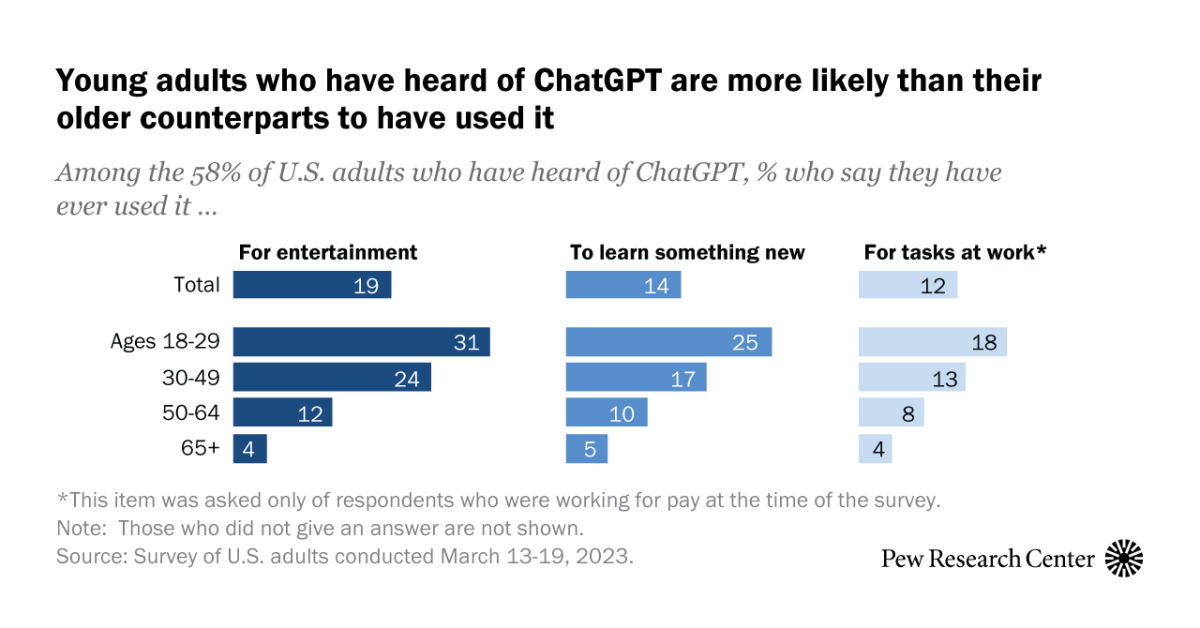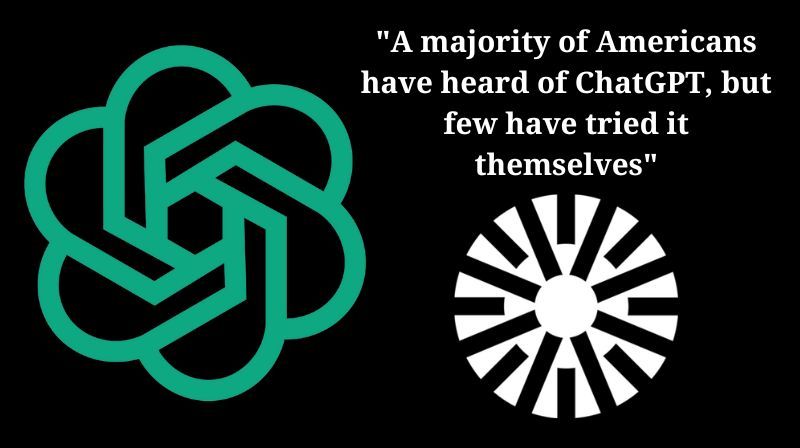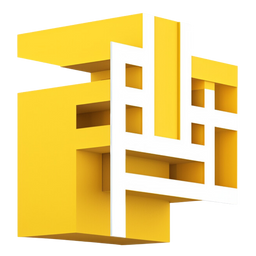In the ever-evolving sphere of artificial intelligence (AI), ChatGPT, an open-access online chatbot developed by OpenAI, has captured global attention with its versatile and human-like responses. Since its public launch in late November 2022, ChatGPT rapidly gained users, breaking records by amassing over 100 million monthly users within just two months. But how does the American public perceive this technological advancement?
Recent findings from a Pew Research Center survey show that while about six-in-ten U.S. adults (58%) are familiar with ChatGPT, only a small percentage have tried it themselves. These statistics are intriguing, raising questions about the reasons behind the limited adoption of this revolutionary AI tool.

The Highlights
The Uneven Spread of Awareness: Demographics and Education Play a Role
Despite the hype surrounding ChatGPT, only 18% of U.S. adults claim to have heard a lot about it, while a significant 42% have heard nothing at all. But a closer look reveals that the awareness of ChatGPT is not uniform across different demographics and socio-economic strata.
Education and income appear to be significant factors affecting familiarity with this chatbot. Among adults with a postgraduate degree, about eight-in-ten have heard about ChatGPT. Similarly, the higher the household income, the higher the probability of being aware of the program.
Race and ethnicity also come into play, with Asian adults being the most familiar with ChatGPT (78%). They are followed by White adults (about 60%), and then Hispanic and Black adults (roughly half).
Additionally, gender and age make a difference, with men and adults under 30 being more likely to know about ChatGPT.
Usage Patterns: A Tool for All or Entertainment for Some?
Despite the growing awareness of ChatGPT, its usage is surprisingly low, with just 14% of U.S. adults having tried it for various purposes, ranging from entertainment to education to work. This under-utilization correlates with a 2021 Pew survey which highlighted that Americans were more apprehensive than excited about increasing the use of artificial intelligence in their daily lives.

The usage patterns show a demographic split similar to awareness. Younger adults and those from diverse ethnic backgrounds are more likely to have used ChatGPT than their older and White counterparts.
The Perception of Utility: High Hopes, Mixed Reviews
While ChatGPT promises a host of applications, opinions about its utility remain mixed. Among those who have used it, about a third found it to be extremely or very useful, while 39% found it somewhat useful. Yet, about a quarter of users reported that the chatbot was not very or not at all useful.
Age plays a significant role here as well. Younger adults are more likely to find ChatGPT useful than older adults, with 38% of users under 50 labeling it as extremely or very useful, compared to 24% of users aged 50 and older.
The Breakdown
Familiarity with ChatGPT

The Rising Star of AI: ChatGPT: ChatGPT, an open-access chatbot, has quickly risen to prominence, breaking records by amassing 100 million monthly users within two months of its launch in November 2022. This attention-grabbing growth has led to about 58% of U.S. adults being familiar with this AI-driven technology, although the rate of hands-on usage lags behind at 14%.
A Closer Look at Demographic Differences in Awareness: In delving into the demographics, interesting patterns emerge. Higher income households and those with more formal education seem to be more informed about ChatGPT. Remarkably, about eight-in-ten postgraduates have heard about the program, while 71% of those holding a bachelor’s degree say the same. This pattern extends to racial demographics as well, with Asian adults more likely to be familiar with the AI program than their White, Hispanic, or Black counterparts.
Actual Usage of ChatGPT

How Americans are Using ChatGPT: While the familiarity of ChatGPT is moderately high, only a small fraction of U.S. adults have utilized this technology. It appears that there's a divide in opinion about how this tool should be employed. Some see it as a valuable resource for education and work, while others perceive it as merely a tool for entertainment. This dichotomy reflects in the usage data: 14% of U.S. adults have used ChatGPT for entertainment, learning something new, or work.
Demographic Disparities in Usage: Just as we saw demographic differences in awareness, the same applies to usage. Younger adults, those under 30, who are aware of ChatGPT, have used the AI for entertainment more frequently than their older counterparts. However, it's worth noting that among those who've heard of ChatGPT, White adults are less likely to have used the chatbot for fun, education, or work compared to Asian, Hispanic, or Black adults.
Perception of ChatGPT's Utility

Controversies and Concerns Surrounding ChatGPT: ChatGPT's meteoric rise hasn't been without controversies. While it can accomplish many tasks, it has been critiqued for inaccurate answers, concocting information, misusing real organizations’ names, and even accusing real individuals of crimes they didn't commit. These issues raise concerns about its overall reliability and the need for robust guidelines for use.
Public Opinion on the Utility of ChatGPT: Despite these challenges, ChatGPT users have diverse views on its usefulness. Around 35% of users find it extremely or very useful, while 39% deem it somewhat useful. A small fraction, however, found it not very useful (21%) or not at all useful (6%). There is also a notable age disparity here, with younger adults (under 50) finding ChatGPT more useful than those aged 50 and older.
The Road Ahead: Overcoming Challenges, Embracing Opportunities
ChatGPT stands at a crossroads, with its potential shadowed by concerns about misinformation and the algorithm’s capacity to fabricate claims. Its user base remains a minority, despite high levels of awareness among certain demographics. However, the utility perceived by some, especially younger users, offers a glimmer of hope.
Future research and improvements could focus on addressing the issues of accuracy and reliability, while further public engagement could seek to bridge the gap between awareness and usage, helping to realize the full potential of this revolutionary AI tool.
Dissecting the Usage Gap: Why Few Users Despite High Awareness?
Although ChatGPT has permeated the public consciousness to some degree, its adoption rate seems remarkably low given the high degree of familiarity. This raises questions about the obstacles preventing widespread usage. Perhaps the concerns raised in the 2021 Pew Research Center survey about the increasing use of artificial intelligence in daily life are still pertinent. If that's the case, then how can we bridge this gap? What steps can be taken to transition from awareness to engagement, from passive familiarity to active adoption?
Demystifying ChatGPT: Is It for Learning, Working, or Entertaining?
The lack of consensus about ChatGPT's best use may contribute to its limited usage. While some view it as an educational and work tool, others see it as a mere entertainment medium. This lack of a unified narrative may confuse potential users about its utility and functionality, thus hampering its adoption.
To counter this, efforts could be focused on promoting the diverse applications of ChatGPT. This might involve demonstrating its use across various sectors, emphasizing its benefits for both work and leisure, and, most importantly, helping the public understand that it is not an 'either/or' scenario, but a 'both/and' situation.
Combatting Misinformation: Ensuring Credibility and Accuracy
Another significant barrier to ChatGPT’s usage is the issue of misinformation. While ChatGPT's eloquent prose and the human-like quality of its responses have made it popular, it has also been accused of making up information, citing nonexistent sources, and falsely accusing individuals of crimes. This misrepresentation of facts and false information can harm the chatbot's credibility, leading to distrust and reluctance among potential users.
Addressing these issues will require rigorous improvements in the algorithm's design to enhance its accuracy. Incorporating rigorous fact-checking mechanisms, refining the content moderation process, and ensuring greater transparency about the chatbot’s workings could alleviate public concerns and boost user confidence.

Prompt Engineering: A Potential Game-Changer in Adopting Generative AI Technologies Like ChatGPT
Prompt engineering—the practice of creating well-designed input prompts to generate desired outputs from AI models—has emerged as a vital discipline in the AI field. By leveraging prompt engineering, we can improve the adoption of generative AI technologies like ChatGPT and enhance their usefulness in work, educational, and personal settings.
Prompt Engineering and Increased Awareness
A significant hurdle in the adoption of AI technologies is the lack of understanding of how to interact effectively with these systems. This is where prompt engineering comes in. By creating well-crafted prompts that guide users in communicating with AI, we can significantly improve user interactions, output generation and enhance understanding of the technology.
For instance, a well-engineered prompt can guide users to formulate their questions or commands more precisely, leading to more relevant and accurate AI responses. As users become more confident in using AI systems effectively, it could lead to increased adoption.
Boosting Productivity at Work
Prompt engineering can also make AI tools more effective and efficient in the workplace. By tailoring prompts to specific professional contexts and tasks, AI can provide more relevant responses, making it a more valuable tool for employees.
For instance, in a business context, a prompt could be engineered to help ChatGPT generate insights from business data, draft emails or reports, or even propose strategies. By utilizing such AI assistance, employees can focus more on strategic and creative tasks, thereby enhancing productivity and job satisfaction.
Enhancing Learning in Educational Settings
In education, prompt engineering can help tailor AI responses to fit the learning needs and levels of students. For example, prompts could be designed to provide explanations of complex concepts, assist with homework, or even generate quiz questions for practice. This kind of AI-enabled personalized learning could revolutionize education, making learning more interactive, engaging, and effective.
Enriching Personal Life
Finally, prompt engineering can also enhance the usefulness of AI in personal settings. By creating prompts that cater to a wide range of personal interests and needs, AI can become a more integrated part of daily life. For example, ChatGPT could help users explore new books, generate creative writing, or even provide conversational companionship, all depending on the design of the prompts.
Looking Forward: Balancing Innovation and Trust
As we stand at the intersection of technology and society, balancing the promise of innovation with the trust of the public is crucial. ChatGPT, like any other AI tool, must strike a balance between pushing the boundaries of technology and ensuring that it serves its users reliably and responsibly. While it has made an impressive start, there is still a long road ahead. Ultimately, bridging the gap between awareness and usage will be key to realizing ChatGPT's potential, turning it from an exciting novelty into a widely adopted tool.









